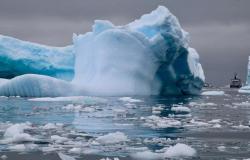All ships passed through the east coast of Florida, United States, on their way to the port of Cuba and are currently only 145 kilometers from US territory. For this reason, air and naval vessels of that country monitored the flotilla.
The arrival of these ships occurs at a time of tension between Moscow and Washington due to the war in Ukraine.
This week, Russian President Vladimir Putin said he could take action if Western countries supply firearms to Ukraine for use on Russian soil.
In late May, Joe Biden’s administration authorized the use of American weapons by Ukrainian forces against targets in Russia.
The condition is that they can only be used in border areas from where Russia has launched attacks against Ukraine.
But, beyond this new escalation of tension, there are several details in the arrival of the Russian ships to Cuba that indicate that it is nothing more than a “propaganda maneuver”, as the head of the Russian service indicated to BBC Mundo. from the BBC, Famil Ismailov.
The group of ships of the Northern Fleet is made up of the Admiral Gorshkov frigate, a carrier of long-range precision missiles; the supply tanker Akademik Pashin, and the rescue tug Nikolai Chiker, equipped with a helipad.
There is also the Kazan nuclear submarine, which has been part of the fleet since 2021.
However, this submarine does not carry nuclear weapons, as reported by Russia.
“It’s interesting that Russia stressed this, that there are no nuclear weapons in this flotilla. It is an indication that sends the message that has no intention of escalating arms“, indicates Ismailov.
Russian Defense Minister Sergei Shoigu explained that the flotilla had previously been carrying out naval exercises in the Atlantic Ocean.
Specifically, they practiced “the use of high-precision missile weapons using computer models against naval targets representing naval groups of the conventional enemy and located at a distance of more than 600 km”, as well as “training to repel an air attack ”.
From Washington it was reported that the forces of that country are monitoring all these movements, but a US official clarified that his country does not consider the arrival of this flotilla to Havana as a threat.
“Russia’s deployments are part of routine naval activity, and we are not concerned, they do not represent a direct threat to the United States,” he said.
“It’s not a coincidence. It is a clear propaganda movement of Russia to make something clear: ‘We support you (Cuba) in the backyard of the United States,’” emphasizes editor Ismailov.
For his part, Ricardo Herrero, executive director of the Cuban Study Group, which promotes greater rapprochement between the US and Cuba, expressed on X (formerly Twitter) that the Russian naval visit to Havana would be “of little concern” for the Department of Defense in Washington.
“But politically it plunges bilateral relations into a deeper hole,” he added.
A propaganda message
“There is an enormous distance between Russia and Cuba, it is too far away and this whole movement takes too much time to see it as a response (to the US decision to authorize the use of its weapons against targets in Russia),” he said. Famil Ismailov added:
“It was something that was definitely planned before.”
In mid-May, the Russian Defense Ministry reported that a detachment of three ships from the Northern Fleet undertook a long voyage from Severomorsk (in the Barents Sea) which was later joined by the nuclear submarine.
This joins the visit this week of the Cuban Foreign Minister, Bruno Rodríguez Parrila, to Moscowwhere he met with his Russian counterpart, Sergei Lavrov.
“We are on the path of strengthening our political dialogue and we are working on impulses to stimulate the Cuban economy,” Lavrov emphasized during a joint press conference this Wednesday.
In July of last year, a Russian navy training ship, the Perekop, also arrived on the coast of Cuba.
It was the first official visit by a Russian warship to the island in many years and was part of the new stage of relations between the two historic allies of the Cold War era, which was also accompanied by several economic agreements.
From the Caribbean island, according to the US military, it is possible that the naval group will head towards another ally of Russia in the region: Venezuela.
“It’s the same type of movement, the same thing. “Venezuela is an old friend of Russia,” said the head of the BBC’s Russian service.
In any case, he emphasizes: “Russia is not a threat in terms of naval force, it is not in a position to make threats to the interests of the United States in the area.”






